2022 Census
IBGE releases unprecedented portrait of quilombolas and emphasizes relevance of consultation to their leaders
July 28, 2023 05h51 PM | Last Updated: August 01, 2023 06h24 PM
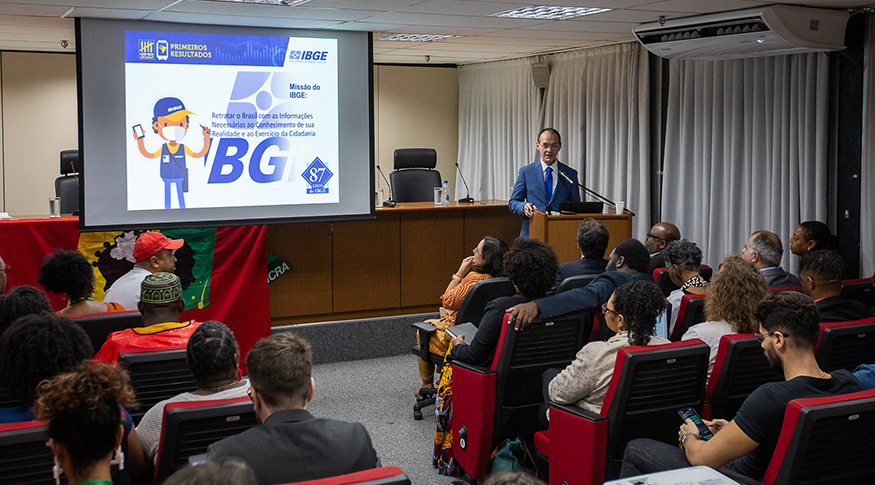
The IBGE released, last Friday, July 27, the first results of the number of quilombolas in Brazi and data about their housing units. The unprecedented survey was received as historical rescue by authorities and, mainly, by many quilombola leaderships attending the event which gathered more than 120 persons in the auditorium of the headquarters of the National Institute for Colonization and Agrarian Reform (Incra), in Brasília.
The information that Brazil has 1,327,802 persons, or 0.65% of the total residents, was a highlight in the press in Brazil and abroad, with news articles published by the British newspaper The Guardian and BBC TV channel.
The acting president of the IBGE, Cimar Azeredo, highlighted that, with these data, the Institute fulfill its mission to portray Brazil. According to him, the main benefit of having an unprecedented survey about the quilombola population is that from now one public policies can be elaborated based on evidences, and not on narratives.
“Now we have quilombolas on the map and next we will have Indigenous persons and favela residents. That is important because these populations are the ones most in need of such statistics. We need to know how many schools, healthcare units, everything these populations need. What we see now is a historical reparation. We have seen the quilombolas identifying with and seeing themselves in the 2022 Census. That makes the IBGE very proud,” the acting president said.
See the first results of the Census for the quilombola population
Brazil has 1.3 million quilombolas in 1,696 municipalities
According to Marta Antunes, who is in charge of the IBGE’s Project Traditional peoples and Communities, the Census of the quilombola population represents a landmark in the history of population censuses. For the first time, the IBGE succeeded in including a population group that, since the Constitution of 1988, has claimed its representation in official statisitcs, cartography and geography.
“The invisibility of the quilombola population, in terms of both data and existence of maps, was countereffected by an encompassing, uncprecedented and trustworthy census. Having the chance of leading this work with my coleague Fernando Damasco, manager of Traditional Territories and Protected Areas, was a unique opportunity to use our academic knowledge, myself as an anthropologist and he, as Fernando, as a geographer, to promote a dialogue between the harshness of public statistics and the necesseties in representation of a particular ethnic group that demands a specific look at their way of being and living, with the technical rigor that characterizes IBGE’s production.”
She also stated that official statistics inaugurated a new chapter for the quilombola population. “Surpassing the imaginary view of remnants of a distant past, the IBGE updates knowledge on the presence of quilombolas in current Brazil, allowing Brazil to get to know the quilombola Brazil,” Ms. Antunes said.
“These results were only possible because we have conducted detailed and encompassing mapping of quilomvola localities in Brazil. Although some studies, academic reports and administrative records provide summarized indications about the location of communities, no other mapping was capable of providing with methodological standardization, geographic deatils and national coverage the distribution of quilombolas in the national territory,” said Fernando Damasco, manager of Traditional Peoples and Protected Areas.
He explained the unprecedented methodology developed by the IBFE in partnership with Conaq (National Coordination for Articulation of Black Rural Quilombola Communities). “The method was based on the identification of quilombos of present times, which produce and organize their territories and, in order to do so, participative cartography, monitored and validated by community leaderships, was of fundamental importance,” Mr. Damasco explained.
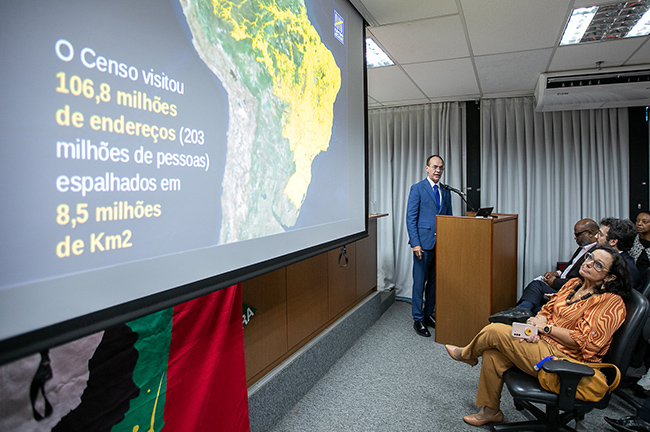

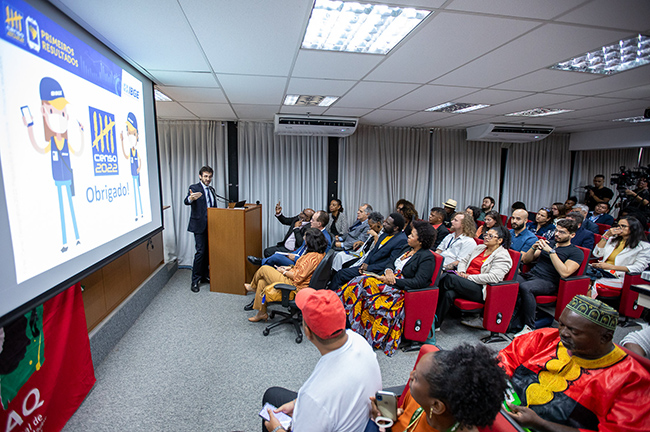
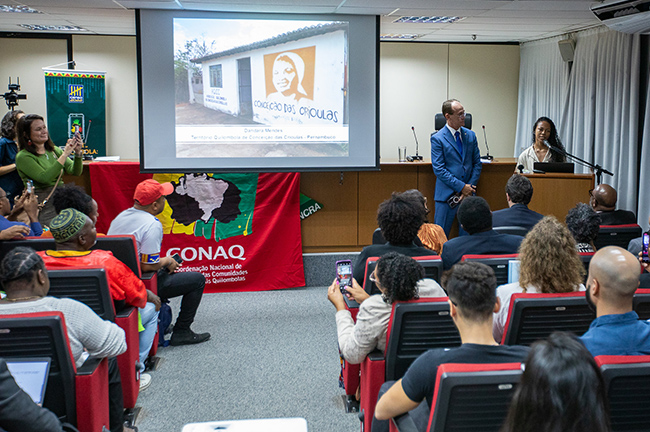
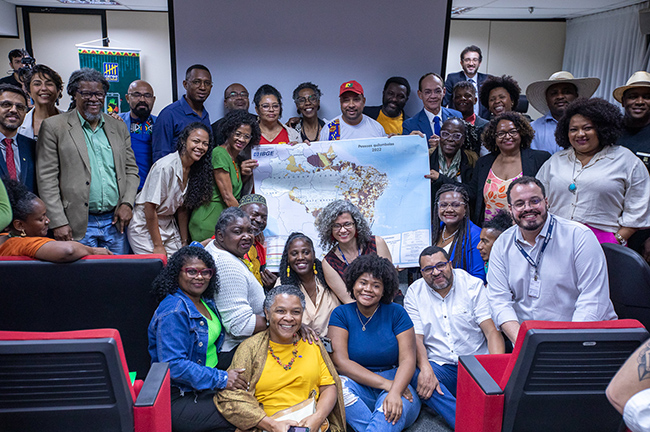
Among the authorities attending the event were João Villaverde head of the Special Advisory Department on behalf of the Ministry of Planning and Budget, and Anderson Oliveira Quack, head of the advisory for Social Participation. The deputy executive secretary Raquel Ribeiro Martins attended the event on behalf of the Ministry of Agrarian Development and Family Agriculture. Representing the Ministry of Racial Equality was the secretary for policies for Quilombolas, Traditional Afro-Descendant Communities and Gipsies, Ronaldo dos Santos. The event was also attended by the director of the International Labour Organization (ILO), Vinícius Carvalho Pinheiro, the president of Incra, Cesar Fernando Schiavon Aldrighi, the representative of the United Nations Population Fund (UNFPA), Forbela Fernandes, and Denildo Rodrigues Moraes, executive coordinator of Conaq.
Among the IBGE servants, stand out, besides the acting president, Cimar Azeredo, Marta de Oliveira Antunes, responsible for the Project Traditional Peoples and Communities, the Manager of Traditional Territories and Protected Areas, Fernando Souza Damasco, the Technical Coordinator for the Census, Luciano Duarte, and the quilombola enumerators Dandara Mendes, Joelita David Bitencourt e Gisely Cordeiro dos Santos, who were awarded during the event.
The head of the Special Advisory Department for the Ministry of Planning, João Villaverde, highlighted it was the first time the quilombola territory is included in a census. He said it took a long time to happen, but from now on this group will always be part of coming censuses.
“In 2030, 2040, 2100 there will be comparisons with what is being done now. On behalf of minister Simone Tebet, we thank everyone attending this event: the Palmares foundation, Incra, the Ministry of Racial Equality, Conaq and the IBGE. The Institute is part of the national heritage, the basis for all we have. If today we know our inflation rate, the level of our economic growth, the unemployment rate and our income, how many we are, who we are and where we are, we should thank the IBGE. On many days, we need to fight. In a country that is poor and with so many difficulties as Brazil, we are defeated sometimes, but we win many other times. It is very significant to be finding out more about the quilombola territories on Marielle Franco’s birthday,” the head of the Special Advisory Department, joão Villaverde, said.
“Today is an occasion to celebrate, because Brazil starts solving some of its history. A country that does not know its people, does not know its history. On behalf of minister Anielle Franco, I want to congratulate everyone here. We are releasing new data on the quilombola population, and showing that, to build policies for the people, it is necessary to build them with the people. That is the reason why Conaq was so important This week we celebrtae the 25th of July, National Day of the Caribbean and Latin American Black W, the national day of tereza de Benguela, quilombola leader, and a week marked by emotion, because today would be the birthday of Marielle Franco, a leader who fought for human right in Brazil,” saide the executive-secretary of the Ministry of Racial Equality, Roberta Eugênio.
The deputy executive-secretary of the Ministry of Agrarian Development and Family Agriculture (MDA), Raquel Ribeiro Martins, mentioned the work of coordinators of Conaq and Incra, the agency in charge of quilombola titles at federal level. “The work developed by the technical team of Incra, in partnership with the IBGE, was essential to consolidade the territorial base for the Quilombola Census. It is of great revelance that the data on this population be continuously monitored, inlcuing and especially during the population Census,” the secretary highlighted .
“It is an honor to receive the quilombola community in this space that it dedicated to the discussion of agrarian issuus, especially the people remaining in quilombos. The Quilombola Census can help Incre enormously in the taks that lies ahead. We neet to speak about land regularization,” said the president of Incra, César Fernando Schiavon Aldrighi.
“Days like today are rare and historic in 523 years of Brazil. These data bring quilombolas out of the basements of invisibility to public management. We need to focus on these policies. I than my workmates from the IBGE and from ministries, and each quilombola leadership, who, even in adverse conditions, worked hard and played the role of the state to advertise the operation and get the quilombolas to receive the enumerator. This Census is an achievement for us after years and will help us advance towards public policies. The data will be used by the Palmares Foudation and all the ministries related to quilombolas,” said Denildo Rodrigues Moraes, aka Biko, executive coordinator for Conaq.
The representative of UNFPA, Forbela Fernandes stated that the data on quilombolas are a landmark in historic reparation and that can be an inspiration for other countries in the African diaspora.
“It is the first time an official survey comments on specific data about the quilombola population. After 135 years of abolition of slavery in Brazil, we finally know how many quilombolas there are, where they are and how they live. The inclusion of the quilombla category and its statistical visibility expresses the recognition of diversity in the Brazilian population and of the historical fight for visibility. This achievement is in tune with international manuals of humann rights, such as the promise of leaving no one behind, of the 2030 Agenda, and the position against racism,” says the representative of UNFPA.




















